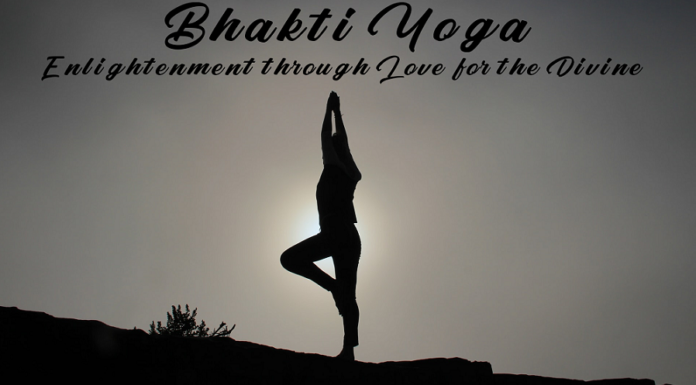THE BASICS : Bhakti yoga is a branch of yoga, or one of the paths that lead to enlightenment.
Bhakti, in layman’s terms, can be defined as intense devotion to god, or a Supreme being. In Bhakti yoga, though, ‘Bhakti’ means unparalleled love towards god. It teaches that love is god, and god is love.
The word bhakti comes from the Sanskrit word bhaj, which can mean a number of things, but in this context represents a relationship of participation, or a ‘partaking’. The devotee ‘participates’ in the person of the deity, slowly losing his/her own ego, or self, and finally becoming lost in the divine persona. The practice of Bhakti yoga is thus a journey towards awakening selfless, boundless love towards a deity or divinity of the yogi’s choosing.
Roots & Beginnings: The Vedas & The Bhagavad Gita (Hinduism)
Yoga is an ancient practice. Its philosophy has a long history, with its earliest appearances being in the Vedas, almost four thousand years ago. It is said that Bhakti Yoga was the only kind of yoga taught in the earliest texts. Yoga was only ever meant to be a path towards developing an all-consuming love for a divine being. It is only with the appearance of the Bhagavad Gita, several centuries later that yoga had become a vaster teaching. Here, one of the paths to moksha that Lord Krishna teaches his devotee Arjun is called Bhakti Yoga.
The Bhakti-Marg movement, which developed and flourished around 800 – 1100 A.D. collected what they called the teachings of the Lord Krishna into a text called the Bhagavad Purana. Here they credit Lord Krishna as saying that the Bhakti Marg is the highest form of devotion which leads to blessings and freedom from sin.
Bhakti Yoga Through The Ages
There are fascinating life examples of people who travelled the path of Bhakti yoga and became legends because of the fierceness, depth, and beauty of their love for the Divine.
One of the biggest reasons for the popularity of the Bhakti Movement was the writing of literature in praise of the god they served. Bhakti literature, consisting of poetry, verses, songs and kirtans have been handed down through tradition and teachings through the ages.
Here are some of the most significant Bhaktas that have made tremendous impact on the world around them through their lives and teachings on Bhakti:
- Ramanujam: the earliest proponent of the Bhakti movement, he is said to have contributed to teaching that Divinity is a subjective term. He was also instrumental in shaking the foundations of the rigid caste-system in India as he taught that even the lowest castes and outcastes were capable of attaining to the highest form of bhakti.
- Kabir: one of the most well-known Bhakti poets in this tradition, his works are legendary and are even taught today. He is credited with shunning the confines of religion and doctrine and taught that love should be the ultimate aim in everything.
- Mirabai: the legendary Bhakti Queen who was the most well-known bhakti singer of her time. She practiced her devotion to her beloved deity in the face of violent oppression from her husband and family. It is said that Krishna (her deity of choice) acknowledged her love to the extent that he saved her from harm that her family tried to bring her to and ultimately absorbed her being into himself at the end of her life. She is also accredited as a great contributor to Bhakti literature.
There are singers and bands that produce work in this genre even today. California-based Jai Uttal travels the world with his music of love, teaching people the philosophy of Bhakti Yoga through his kirtans and japa sessions.
Philosophy
As stated earlier, ‘bhakti’ means devotion, or love. This form of yoga is ultimately aimed at uniting the bhakta with the Divine. Through the practice of this yoga, the devotee or bhakta devotes himself or herself to the pursuit of love in its purest and highest form. According to Bhakti philosophy, we experience lesser forms of this love in our daily lives. A bhakta on this path uses senses, emotions, and actions to express love to the highest degree possible. It is an act of worship to their chosen deity.
According to Isha Sadhguru, Bhakti yoga harnesses the emotions of the yogi – the most intense part of his/her being. While the intellect, energy, and the mind can show varying spurts of intensity from time to time, the emotional self of man is the most recognizably volatile and all-consuming aspect of all the human faculties. Left to our own devices, it is usually the negative emotions that hold sway in our lives, unless some intensely positive force causes love or joy to consume our beings.
In the words of the Sadhguru, Bhakti Yoga is simply the act of conditioning our faculties to project love and positivity as the dominant response to everything in the Universe. This exercise is aimed at recognizing a Higher Power that is worthy of this higher standard of love. Our indulgence in love and service through Bhakti Yoga is an act of worship towards this Higher Power.
Our recognition of a higher power would also mean that we recognize the true nature of our own selves, our place in the Universe. This brings a sense of humility that is not otherwise possible. The Sadhguru says that when we look at the Universe and everything around us, we become aware of the fact that we are all super-miniscule parts in a humongous system. This leads us to worship even the smallest pebble that is capable of a stronger, more lasting existence than us. This is where the practice of Bhakti Yoga leads us.
Further Musings
Bhakti yoga is said to be the easiest form of yoga. The four paths towards enlightenment as explained by Lord Krishna in the Bhagavad Gita are:
- Jnana yoga, the path that calls on intellect and knowledge – requiring the exercise of the mind towards the pursuit of learning
- Hatha yoga, the path that calls on your physical ability – requiring the exercise of the body through asanas
- Raja yoga, the path that calls on disciplining the mind – requiring the exercise of the higher abilities of the mind through meditation and chanting
The fourth path, Bhakti yoga, on the other hand, requires nothing more than a loving heart. It is more of a shedding away of negativities inside the heart and mind, so that everything is overflowing with love.
Interestingly, bhakti yoga philosophy stresses that each yogi assigns himself/herself the deity of choice. This means that the yogi is free to find his or her own object of devotion, whether from the pantheon of Hindu gods and goddesses, or from their own cultural and religious backgrounds, or any other guru/saint/object that evokes endless love in the bhakta. Because of this non-restrictive philosophy, proponents of Bhakti Yoga state that it is not religion, caste, or gender- restricted. In fact, during times when the caste-system was a rigid social structure in colonial and post-colonial India, Bhakti yoga was called a social leveler since love for god could be expressed by anyone. It becomes the answer to religious and communal frictions as well in today’s context.
How Is Bhakti Yoga Practised?
Bhakti Yoga is unlike any of the other forms of yoga that are popular today. It is, in fact, a slightly lesser known form of yoga, that is only just beginning to find a greater following. In some ways all forms of yoga are intertwined, and true yoga ultimately aims towards the ultimate consciousness of the Divine.
Bhakti Yoga does not involve the practice of breathing exercises or physical movements through asanas. The ultimate aim here is to worship your chosen deity through song, devotional chanting, and worshipful service.
There are nine practices called ‘limbs’ of Bhakti yoga. These are designed to evoke specific bhavas or feelings in the yogi. Here is a gist of the nine limbs:
- Shraavana: ‘listening’ – periodic, sustained listening to ancient scriptures, especially at the feet of a religious guru, genuine bhakta, or saint
- Kirtana: ‘singing’ – singing of devotional songs and hymns, usually as a group
- Smarana: ‘meditating upon the name of the Divine’ – this is the act of continuously remembering the name of the Divine
- Padasevana: ‘service at the feet of (the Divine One) – a practice that involves service-oriented worship
- Archana: ‘rituals’ – worship of a deity through rituals like puja and homa.
- Vandana: ‘prostration’ – the act of worship through lying face-down in front of the deity, or representation of the deity
- Dasya: ‘servanthood’ – superior love and service to the Divine through assuming to follow its will, rather than one’s own ego
- Sakhya: ‘camaraderie’ – devotion that sees the Divine as an intimate friend
- Atmanivedana: ‘complete surrender’ – self-offering worship that completely negates the ego and personality of the yogi and loses itself in the person of the Divine one.
There are five bhavas that the Bhakti yogi or yogini can practice in devotion to the Divine One. Bhava is a state of being in which the devotee reaches the state of devotion where there is complete self-negation. Bhava grows into maha-bhava, a greater identification with the Divine Self, and then Parama-Prema, a state of ultimate ‘consummation’ of love for the Divine.
The five bhavas are:
- Shanta – A state of peaceful indulgence in the overflowing love toward the Divine.
- Dasya – The devotee feels the ultimate expression of love in selfless service.
- Sakhya – This is similar to the eighth ‘arm’ detailed above, where the devotee treats the Divine entity as a friend, just as in the relationship between Arjuna and Lord Krishna.
- Vatsalya – is a unique bhava in which the devotee looks upon the Divine entity as a favorite child. This can be exemplified in the relationship between Lord Krishna and his mother Yashoda. The devotee feeds, clothes, and cares for the representation of the deity when they are in this bhava.
- Madhurya or Kanta – is the highest form of love – described as the consummate love seen in the ancient texts as the relationship between the Lord Krishna and his consort Radha.
The Purpose And Benefits Of Bhakti Yoga
So why do people need to experience and spread this all-encompassing love? If we look at the word today, it is obvious that a spiritual practice like Bhakti Yoga brings people relief from the oppressions of stress, negativity, and even depression. Turning our emotions continuously towards the positivity and love that is outside of ourselves and greater than ourselves gives us a sense of purpose, grounds us in the reality of our existence, and severs us from a superficial mode of living.
As one bhakta put it, it helped her to stay aware, as well as positive.
Conclusion : So, this post has given you a bit of a background into the style of yoga called Bhakti Yoga. It is definitely something that everyone can, and therefore should, experience. The kind of love that transcends situations, circumstances and physical identities and ties us to a greater power, while grounding us in the reality of our true nature gives us a sense of purpose. It keeps negativity at bay and cleanses us of the darkness that our circumstances can grow within us. It brings us to a place of peace that is greatly needed in the world today.





[…] some types of yoga are a lot more religious than others. Hare Krishna monks are practitioners of bhakti yoga, which is undoubtedly more spiritual than the West’s popular conception of hatha yoga. It is […]
[…] clearly gives a glimpse of what a true yogi is. A yogi is essentially an expert in the entire nine processes of Bhakti Yoga and not only asanas. For a layperson, Yogasnas help only if it is followed by the right procedure. […]